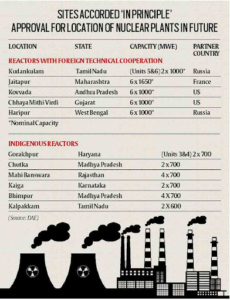About the Kudankulam Nuclear Power Plant (KKNPP)-
- It is the largest nuclear power station in India, situated in Kudankulam in the Tirunelveli district of the southern Indian state of Tamil Nadu.
- Construction on the plant began on 31 March 2002, but faced several delays due to opposition from local fishermen.
- KKNPP is scheduled to have six VVER-1000 reactors built in collaboration with Atomstroyexport, the Russian state company and Nuclear Power Corporation of India Limited (NPCIL), with an installed capacity of 6,000 MW of electricity.
- Russia is building the KKNPP under an Inter-Governmental Agreement of 1988 and follow-on agreements in 1998 and 2008.
- Unit-1 joined the grid in October 2013 and Unit-2 was connected to the grid in August 2016.
- The first power unit of the Kudankulam plant has been steadily operating since February 2016 and the second was included in India’s national electricity grid in August 2016.
- The master framework agreement with Rosatom for the construction of the third and fourth units was signed in 2014.
- An agreement was also signed between India and Russia (Rosatom State Corporation) in 2017 for construction of the fifth and sixth power units at Kudankulam.
- Russia’s state atomic energy corporation has started manufacturing the nuclear reactor and steam generators for the sixth unit of Tamil Nadu’s Kudankulam nuclear power plant.
- Rosatom is currently building the 6,000-MW project at Kudankulam, which will have six VVER-1000 nuclear reactors, and is in talks with India to construct six more reactors at a new site that is yet to be identified.
Major Nuclear reactors in India (other than Kudankulam)-
Tarapur Nuclear Reactor-
- Located in Maharashtra, it is the oldest nuclear facility in India, having commenced commercial operations in 1969.
- It is currently the second most powerful in India, with two BHWR of 160MW and two PHWR reactors of 540MW forming a total of 1,400MW.
- The nuclear plant is the result of New Delhi’s collaboration with the US.
Rawatbhata Atomic Power Plant-
- Located in Rajasthan, it has a total installed capacity of 1180MW. Formed of six PHWR reactors with two more reactors planned, the first reactor was commissioned back in December 1973.
- Earlier India collaborated with Canada for this plant.
- In 1974 after India conducted Smiling Buddha, its first nuclear weapons test Canada stopped their support of the project.
Kaiga Atomic Power Plant-
- Located in Karnataka, it is formed of four 220MW PHWR reactors making a total of 880MW.
- The plant has been in operation since March 2000 and is operated by the Nuclear Power Corporation of India Limited (NPCIL).
Kalpakkam Nuclear Power Plant-
- LOcated in Tamilnadu, it first began operating in 1984 and currently has two 235MW reactors, with two more reactors of 500MW and 600MW to be added at a later date.
- It has a prototype fast breeder reactor (PFBR) which does not produce highly radioactive nuclear waste and can produce 70% more energy.
Narora Nuclear Reactor-
- Located in Uttar Pradesh, it has two PHWR which offer a total capacity of 440MW.
- It is considered one of the safest nuclear plants in the country and won a Golden Peacock award for environment management in the year 2000.
Kakrapar Atomic Power Plant-
- The power plant in Gujarat, Western India has two PHWR reactors with a total installed capacity of 440MW.
- It is developed and operated by NPCIL.


Further reading: https://journalsofindia.com/distribution-of-atomic-power-plants-in-india-2/
















